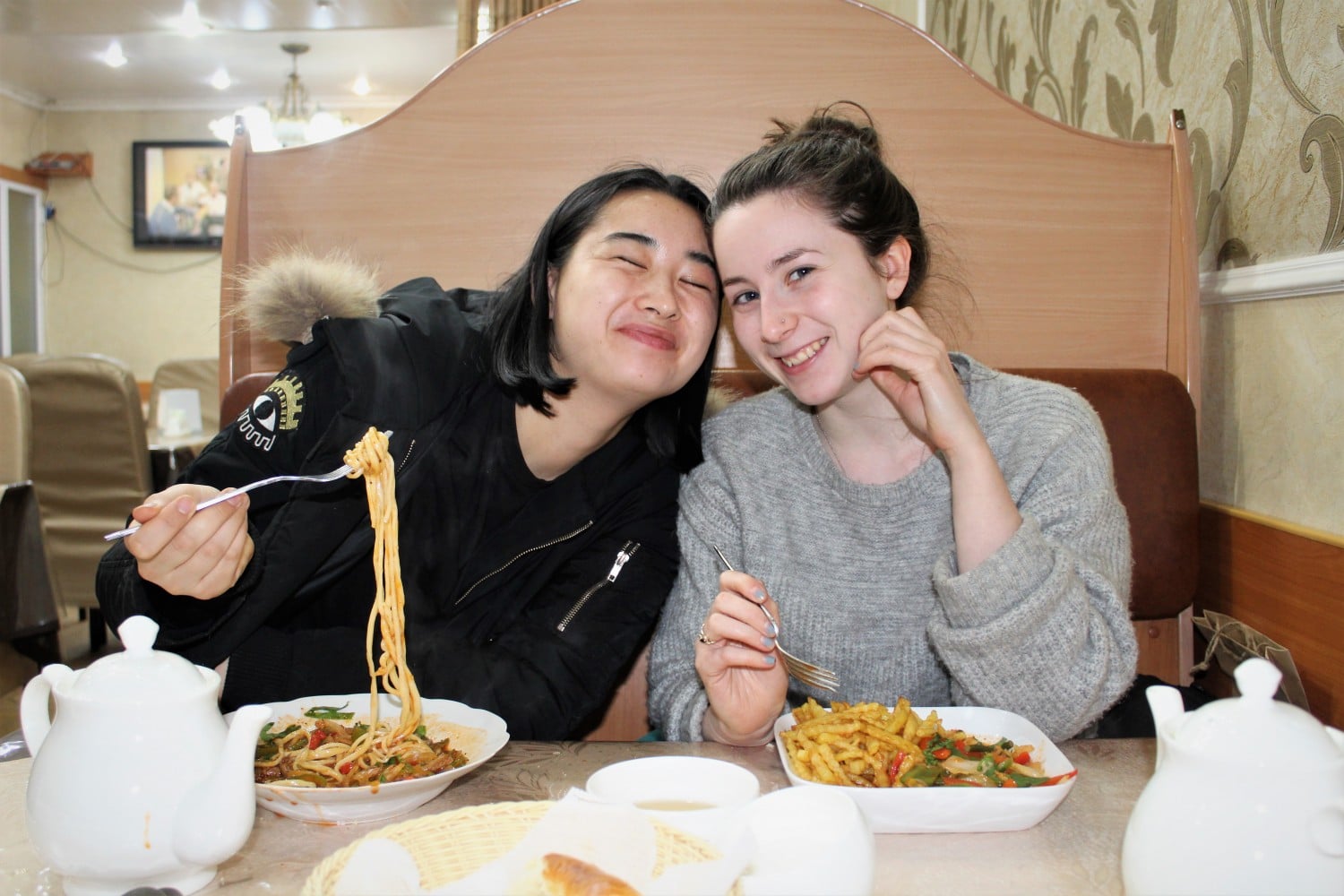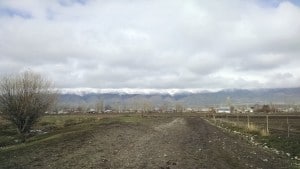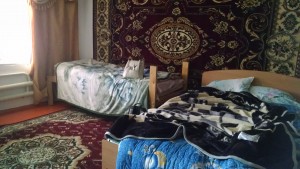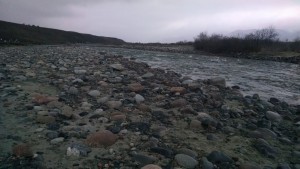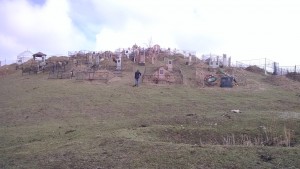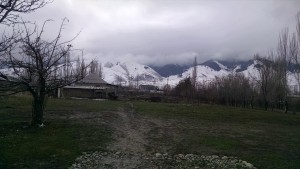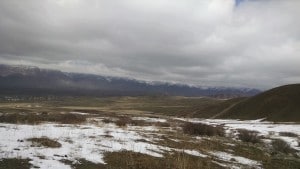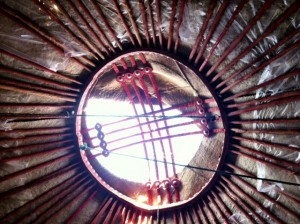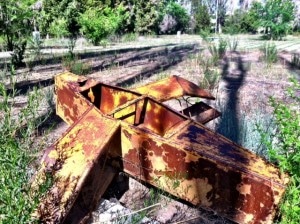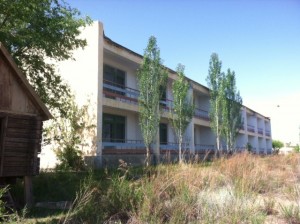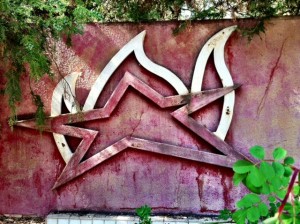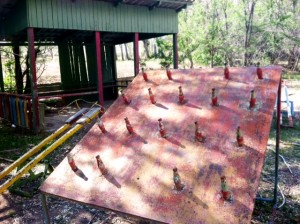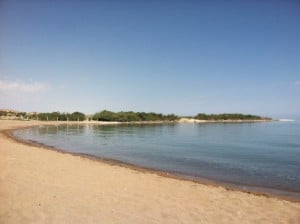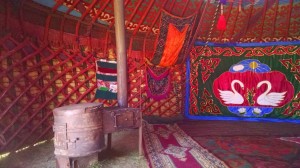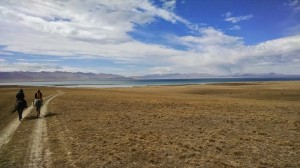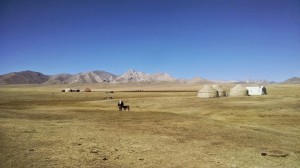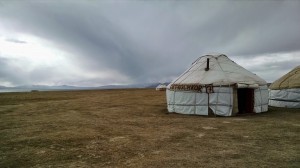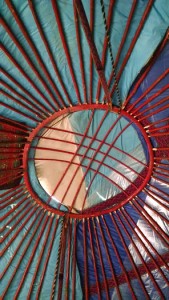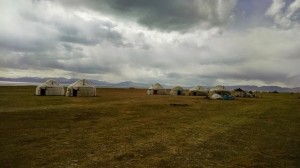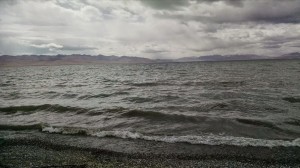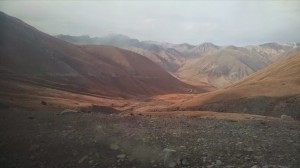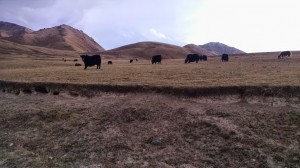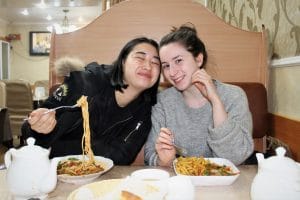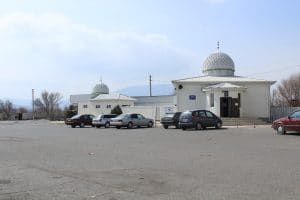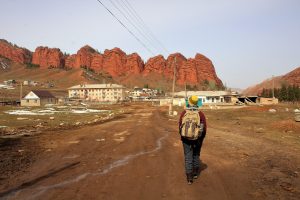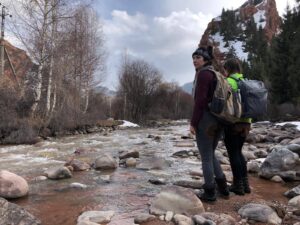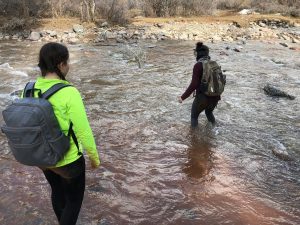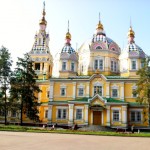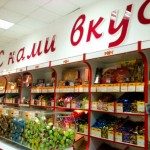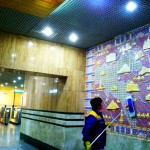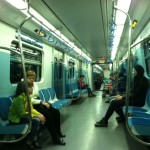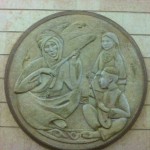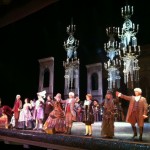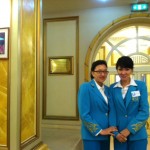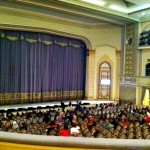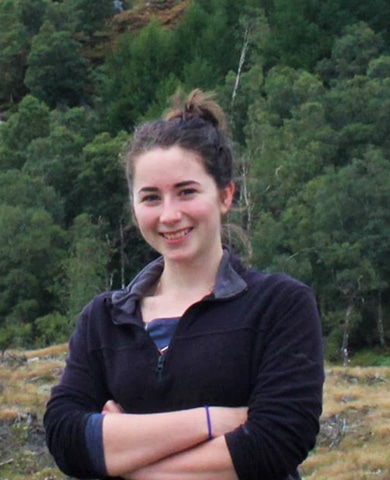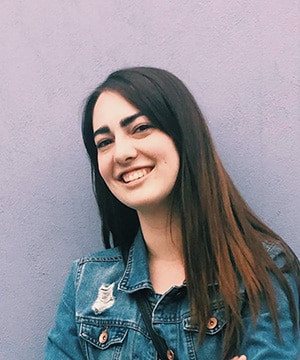Kyrgyzstan is a small country that abounds in natural beauty – many great locations are just a short drive away and can be experienced on a surprisingly small budget. Many of these independent student experiences were arranged through a company called Community Based Tourism, which seeks to use local guides and local resources to make tours and experiences the best value to both you and the communities you visit. Students have consistantly given them high marks.
Some of these also duplicate experiences that our students might have on our study abroad programs in Bishkek. There is no reason not to go back and explore further!
Chong-Kemin: Nature, Hiking, and Locals
2.5 Hours from Bishkek; 2 day trip
Budget: $20 per person (sharing expenses between three friends)
Review by Sophia Rehm (Fall, 2014)
Chong-Kemin Valley is home to villages, a national park, and a state reserve just two and a half hours from Bishkek by marshrutka. I visited a village in the valley with two friends in March, travelling through CBT (Community Based Tourism). With more time I’m sure we would have explored Boom Gorge and maybe spotted the pheasants, hares, and ephedra the reserve is in place to protect. As it was, we enjoyed breathtaking landscapes, hiking in the foothills, and wonderful food and hospitality.
Mist, Mud, and Mountains
Chong-Kemin is CBT’s closest destination to Bishkek. The company houses guests in a lovely guest home in Karool-Dobo village. I made arrangements for our trip in typical CBT fashion: CBT’s office in Bishkek gave me the number for the Chong-Kemin coordinator, who said he would be expecting a call from us once we reached the village on Saturday morning.
Marshrutkas to Chong Kemin leave from Bishkek’s East Bus Station once an hour, and cost 120 som ($2) per person. I slept through most of the scenery on the way to the village on Saturday morning, and when I woke up, our now half-full marshrutka was rocking along a dirt road between private houses. Fields, and beyond them, mountains, stretched behind the houses on both sides. My friends – one local, one visiting me from Europe – asked me if we were almost there, as though I might somehow recognize Karool-Dobo in a particular fenced-in house or group of cows. The driver confirmed that we’d reached the village, but couldn’t tell us where a guest house was located, nor could anyone else on the marshrutka, though everyone wanted to help. I called the coordinator who asked to speak to the driver – I love how often in my life here I’m prompted to put strangers on the phone with each other to help me. After a brief conversation in Kyrgyz, the driver told me he knew where to drop us, and that we’d be met there.
A few minutes later, we were deposited on the side of the dirt road. It was a gray day, and the cows in fenced-in yards looked gloomy. But it smelled refreshingly of hay and animals, and down every one of the dirt paths to each side of us, off the main road, we could see the gentle mountain peaks. A small boy, one leg over his bike, said hello to us in English when we got out of the marshrutka. He looked questioningly at us for a minute, then biked away across the road and down a side street. Several men passed on horseback. I called the coordinator again, and a few minutes later a woman appeared, waving and shouting to us from down the path where the boy had disappeared. “My little brother came to meet you!” she said when we reached her, as she lead us into her yard. “He told me ‘I said hello, but they didn’t come with me!’”
The guest house is large and comfortable, and our room was beautiful. Three big beds were piled with thick, colorful comforters. A table in an adjoining room was already covered with bread and jam, and we drank tea and talked to our hostess, Lira, before taking a walk in the direction she’d pointed out, where she said we could find the Chong-Kemin River.
It was drizzly and cold and the fields were deserted and still unplanted. The river turned up unexpectedly, below a steep and sudden incline. We sat by the cold water, picked up colorful pebbles, and walked home to have dinner and warm up.
Hospitality and Hiking
Our hostess was accommodating and kind about my vegetarianism. We had buckwheat kasha and stewed vegetables and rice, and delicious carrot-noodle salad. After, we had just-baked bread and jam and lots of tea. After dinner Lira brought in her комуз, a national instrument something like an unfretted 3-stringed lute, and played and sang for us, beautifully. She let us each try out the instrument, and then she played some more and we talked until it was time for bed.
I came to Chong-Kemin for the nature and hiking and experience, of course, and not for the food, but as often happens in my experience here, I spent much of my time in the village eating. Breakfast was thick, sweet rice kasha and more bread and jam and tea. Overfull, we started walking in another direction, the way Lira had suggested to best reach some foothills for hiking.
It had rained overnight and almost no one but us was trudging through the muddy lanes that morning. Across some fields we reached a beautiful cemetery on a hill, sending some goats running up ahead of us as we approached. The view from the top of the hill was gorgeous. One shepherd walked a thin path along the crest of another hill below us with his sheep. I said something about the landscape looking like a photograph I’d seen as a child and always wanted to witness in person. My friends’ eye-rolling didn’t take away from the personal satisfaction of the moment.
We made our way along the foothills slowly, stopping to commune with cows and hold eye contact with groups of sheep. We followed a thin stream uphill, the ground getting snowy under our feet. After a while, one friend decided to wait by the stream while I and my other friend continued up. I was determined to reach a cluster of ёлочки (spruce trees) Lira had described.
The trees were of course much farther than they appeared, and I accidentally abandoned my friend in a snowbank as I plowed my way up. Don’t do this if you go to Chong-Kemin. Also, don’t underestimate the fog that can sweep in very suddenly and erase all visibility in the mountains. I reached my trees, waist deep in snow and soaked from the icy stream, and when I turned around to head down the way I’d come I could see almost nothing.
I found my wet, cold, angry friend where I’d mistakenly thought she’d wanted to wait for me just below the trees. We were able to follow the stream in the white fog and finally find the third member of our party – also cold, worried, and not entirely happy with me. We tripped and shivered along in the white emptiness, at one point running excitedly toward a figure we thought could help us, only to find yet another cow, the experience remarkably resembling Hedgehog’s in the wonderful Ёжик в тумане cartoon.
Luckily, my friend’s sense of direction is far superior to mine and we eventually reached our little village, muddy and freezing. Electricity had gone out but the house was still cozy, and we drank an enormous amount of tea. My friends warmed back up to me with the tea, and Lira laughed at us in a friendly way. Then we packed our things and ran through the mud to flag down the once-an-hour marshrutka back to the city, just in time.
Короче (in short, as they always say in Russian) – Chong-Kemin is lovely, and I highly recommend going there through CBT. Our two meals, one night’s sleep, and warm welcome cost us each about 800 som, or about $13. The guest house was beautiful and – with the enormous warm blankets and heaps of food – luxuriously comfortable. The hiking is beautiful, just consider bringing more common sense with you than I had at my disposal – or embrace the possibility of Hedgehog-style adventure.
Bokonbayevo: Exploring a Soviet Pioneer Camp
4 Hours from Bishkek; 2 day trip
Budget: $20 per person (sharing expenses between three friends)
Review by Eirene Busa (Spring, 2013)
The best parts of Kyrgyzstan summers are weekend getaways to Lake Issyk Kul, one of the world’s deepest and highest lakes. Issyk Kul, which means “hot lake” in Kyrgyz, is the ultimate beach destination. It’s “hot” because it never freezes – but that is due to its salt content, not because it’s actually hot.
Lake Issyk Kul is what the Hamptons are to New Yorkers and the Outer Banks are to Washingtonians. Every other week, Bishkekers will get in a car or mashrutka, drive about four hours through the narrow, winding mountain roads, and escape, at least temporarily, the oppressive summer heat in the capital. Although I am only now spending my first summer in Kyrgyzstan, I already know this well because the moment I arrived in this country in January, in the middle of a colorless, depressing winter, I heard from locals that this is simply what’s done; and that if I was smart, I’d do the same thing. The moment the heat arrives, Bishkekers leave.
So this past weekend, I followed suit and went to Issyk Kul, to the southern shore near the small village of Bokonbayevo. Actually, it’s not even that hot yet in Bishkek, but after sweating it out the past couple of weeks in my homestay, it was time for a brief respite. It was also an opportunity to celebrate with a friend who was leaving Kyrgyzstan after a two-year career here. This was her final hurrah, her final swim in the legendary mountain lake of the country she has grown to love and cherish.
Now, before the locals start groaning about how it’s still too early for beach season (peak Issyk Kul season is end of July through August), and how the northern Issyk Kul towns of Cholpon-Ata and Karakol are where it’s really at for said “good times,” let me just say, the south gets a bad rap. It’s peaceful in the south of Issyk Kul. It’s less touristy. And honestly, now is the best time to go to Issyk Kul because, as I hear, the roads are not as clogged with beach-bound traffic, and the beach is not yet completely overrun with tourists, expats, and local university students. The southern shore of Issyk Kul is also just as stunning as the north, and quite possibly even more so beautiful because of its raw, less-developed state. So, dear readers, don’t listen to the naysayers. The south is an under-appreciated gem of Issyk Kul.
We booked accommodations there through Community-Based Tourism (CBT), a company I would recommend. In Bokonbayevo, CBT has a yurt camp with four medium-sized yurts to sleep in, one outhouse, a dining yurt that serves three traditional Kyrgyz meals a day, and plenty of land to set up personal tents and park your own vehicles. It’s a modest, but ideal place for backpackers and low-key Bishkekers who want nothing more than the opportunity to sleep in a yurt at night, and sunbathe during the day. During our stay there, we met backpackers from Germany, Russia, England, and Finland, some of whom even studied and taught at the London School a while back. (Small world!) Just don’t wait too long to book a stay. When we visited this past weekend, CBT Bokonbayevo was in the middle of expanding the facility, already completing some stone walls and rooms during our 48-hour stay. So word is traveling fast. (Get there now before it commercializes and gets more expensive!)
There is much to do in Bokonbayevo, and СBT, with its English-speaking staff, can help you arrange it. You can go on an eco-trek into the nearby Terskei Ala-Too Mountains, where the critically acclaimed Kyrgyz comedy Boz Salkyn (2007) was filmed. You can visit the hot springs, a small salt lake, and the Chasha Manasa, the longest waterfall in Kyrgyzstan. You can also go horseback riding and fishing. You can even ask CBT to bring in a Kyrgyz falconer, which some Russian travelers did while we were at the beach; apparently they got to witness a live capture of a wild rabbit.
You can also visit an abandoned Soviet pioneer camp, which is about a 10-minute walk from CBT’s yurt encampment. This was definitely one of the highlights of my weekend. As we wandered through this facility that once trained Soviet children in survival skills and Leninist values, but which was now overrun by weeds, wild cows, and rust, I could almost hear the ghost voices of marching children in red scarves chanting in unision, “Always love your homeland!”, “Respect your elders!”, and “Help those younger than you!” I also happen to have a strange fascination for abandoned buildings and Soviet playgrounds. This place, with its lush greenery, chipped murals, broken windows, white-washed dorm rooms, and ant hills, would make a great photojournalism essay about, say, the state of Kyrgyzstan’s Soviet past. I can see the National Geographic Magazine story now, the front cover being a faded red star on one of the courtyard walls that conveys a past gone with the wind.
But even that wasn’t the best part of the weekend. The best part was stumbling upon a beach that belonged to the Young Pioneer camp. It was smoother, sandier, and even more private than the beach at our yurt encampment. We marched down the paved walkway that led directly from the camp to the water, like victorious scouts that unearthed a great secret. And then we spent most of the weekend there, lying in the sand, wading in the ice-cold Issyk Kul water, and admiring the breathtaking view of the snow-topped mountains in the distance.
Of course, the beach was no secret to the locals. Throughout various parts of the weekend, we had to share the beach with three wild cows and a horse, who also wanted to sunbathe and roll around in the smooth sand. At one point there was even a wild Kyrgyz party of 50- and 60-somethings celebrating a 30-year wedding anniversary with vodka, beer, a videographer (i.e. a young kid holding a video camera, obviously assigned the task of documenting the celebration), and a properly gregarious accordion player. They were definitely a spirited group. At around 1pm, they spilled out of their mashrutkas (which they had parked right on the beach) already intoxicated. The rest of the day they sang Kyrgyz national songs, quaffed from an endless supply of bottles, stripped to their underwear, wobbled and collapsed onto the sand several times, and dragged each other into the ice-cold water in a fit of protesting shrieks and giggles. And some of them were my parents’ age, some seemingly my grandparents age! Meanwhile, the rest of the beach, which consisted of families, teenagers, and yuppies just grinned and laughed good-naturedly at this rambunctious party, which was oblivious and/or simply uncaring about the rest of the beach’s opinions.
I later learned, upon returning to Bishkek, that what I witnessed on the beach was quite normal. One of my Uzbek colleagues said that people often like to celebrate occasions in a drunken, song-filled lore – although she had to add that this happens much less in the Uzbek-populated south, which tends to be more conservatively Muslim. My Kyrgyz host mom was also unfazed.
Of course, I’m not saying you won’t find similar instances of fun, neat discoveries, revelry and joy on the northern shore. I just want to point out that there is also fun to be had on the southern shore. Thus I urge you to not overlook this part of the lake as you plan your weekend excursions over the Kyrgyz summer.
Speaking more generally, I’m also happy to report that summer in Issyk Kul lives up to the hype. I look forward to many more trips to this mountain lake the next couple of months, taking in as much as I can of Kyrgyzstan’s natural beauty. And by the way, to the SRAS students who are just now arriving for beach season: The water feels just fine.
Lake Song-Kol: Yurts, Horses, and Swimming
5 Hours from Bishkek
Budget: $20 per person (sharing expenses between three friends)
Review by Sophia Rehm (Fall, 2014)
Lake Song-Kol (Russian Сонкёль, Kyrgyz Соңкөл), the largest fresh water lake in Kyrgyzstan, lies at 9,895 ft in the peaks of mountains in Naryn Province. It’s one of the most magical places I have ever visited. I loved it more than the larger, more widely known and visited Lake Issyk Kul. At Issyk Kul, the mountains just visible on the opposite shore are both towering and impossibly far away, and the lake is endless to the right and the left. At Song-Kol, the whole lake sits well within your field of vision, as do the slopes of the mountains around it. Because so much space is visible here, everything appears small. I almost thought I could walk around the lake in an afternoon, or run up the seemingly-smooth side of a nearby peak. It’s only when you start to walk that the space stretches out around you.
Two friends and I arranged a weekend trip to Song-Kol with Community Based Tourism (CBT), an organization I highly recommend. The purpose of the company is to simultaneously promote tourism in Kyrgyzstan and traditional Kyrgyz lifestyles. To that end, travelers are housed with local families, assisted by local guides, and driven by local drivers. Most of the (reasonable) fee for a trip goes to the local people hosting and facilitating it.
CBT has an office only a couple of blocks away from the London School in Bishkek, at 58 Gorky St./ Горького 58. There, my friend and I were greeted by a man at a desk who immediately assisted us. We asked about prices and itineraries for a trip to Song-Kol for the coming weekend. There were several options available to us for lengths of stay and quantity of horseback riding. We decided we wanted to spend a single night, and spend one day riding horses around Lake Song-Kol. The total cost would be about 11,300 soms ($205), or about $68 a person. The price included: a taxi drive from Kochkor to Song-Kol (about three hours) and back; a night’s stay in a yurt next to the lake; dinner and breakfast; a night’s stay and meals for the driver (who stays with the family as well); three horses for the three of us for a day; and a horse guide for the day (and his horse).
This information was explained and written down for us at the CBT office, and we were given the number of the local CBT office in Kochkor. When we called, we were told we couldn’t formally arrange the trip in advance – we should call upon our arrival in town on Saturday morning and arrange everything with the office there.
The marshrutka ride to Kochkor is about 3 hours. We called the office from the center of town, and were met a few minutes later by a friendly, professional woman who spoke to us in English and led us the few blocks to the small, pretty house that serves as the CBT office. About ten minutes later, we had arranged everything with someone in the office (also in English). A few minutes after that, we were picked up in front of the house by our taxi driver.
The drive from Kochkor to Song-Kol is a stunning three hours on narrow mountain roads. We wound around peak after peak after peak. Once, the driver said “yak,” and we looked down the slope beside us to see enormous, shaggy, slow yaks eating grass and resting in the sun. Later, in one of the narrowest sections of road, we crossed paths with a small truck, carrying a family and the piled pieces of a disassembled yurt. We stopped at the edge of the road and our driver spoke to the people in the truck through the window – they were his relatives (as were, it turned out, the people we stayed with by Lake Song-Kol).
We finally turned off the mountain road onto a narrower lane, driving up a short incline so steep it seemed the car would tumble over backwards. We wove around a hill or two and then drove along a dirt road across a plane towards the white yurts clustered by the shining lake. Horses and cows and the occasional donkey stood in groups across the field, grazing.
The three of us had a large yurt to ourselves, with three mattresses laden with heavy comforters, which we needed during the cold night. The walls were decorated with multi-colored, multi-patterned fabrics, a small metal furnace promised coziness after dark, and the тундук, capping the hole in the center of the peaked roof, opened onto a bright blue sky.
I was nervous about my vegetarianism – not because I thought I’d be hungry (I rarely travel far without nuts and bread and cookies), but because I didn’t want to offend our hosts by refusing their food. But when we met our hostess and I began to say “I don’t eat…” she finished for me: “You don’t eat meat?” Relieved, I joined my friends for an evening walk before dinner.
It quickly became apparent that walking around Lake Song-Kol was laughably unrealistic. Space seemed to get larger and larger as we walked. The earth along the water was a Dr. Seuss-like terrain of grassy, bulbous mounds, which exhaled disconcertingly, like small animals, as we hopped from one to another. We met cows who stared us down, and baby horses nursing beneath their chewing mothers. We passed a second small yurt camp, a small distance from ours, and then saw no other signs of habitation in front of us, or across the lake. We felt very far away from everything and everyone – and were all the more surprised when a backpacker rounded the next hill, and spoke to us in English. He was German. Next, we met two women from France. Even in late September, even on top of the mountains, we were not so remote. The animals who seemed to own the place in fact spoke of a vibrant жайлоо, (“jayloo,” summer pasture) and fellow travelers were enjoying the unusual beauty with us.
We ate dinner in our host’s yurt, three doors down from ours. There was hearty vegetable soup, and the now familiar piles of bread, cookies, борсоки, and (most importantly, as far as I’m concerned) glass bowls of iridescent jams, in vivid purples and oranges and reds. There was fish as well, for the non-vegetarians. And endless чай (tea), of course. We ate with fellow-travelers, from Germany and Japan.
The day had been hot and bright and sunny, but the night was sharp and cold. The stars, which I’d been eagerly awaiting, were as bright as I had hoped, and I saw the Milky Way clearly for the first time.
We wore sweatshirts to bed under our heavy blankets and stayed warm in our yurt. We woke to a much colder day, and a breakfast of rice каша (porridge) and fried eggs, bread and jam, tea and cookies. And then we mounted the horses waiting tied to a post outside, with the help of our guide, a boy of about sixteen who said very little that day other than “Right!” and “Left!”
My most substantial horseback riding experience had been a half-hour ride a few weeks before, near the Tian Shan Mountains on an SRAS trip to Issyk Kul. I had learned “chu” (go) and “drrr” (stop), and had a vague sense of how to pull on the reigns to turn. And that was really all I needed. We rode slowly, across the expanse of field and around the hills that had looked small and compact from afar, but which hid streams and herds of sheep and small valleys between them. In addition to our quiet guide, who pushed or pulled our horses when they turned the wrong way or stopped too long to eat, we were accompanied the whole way by an enthusiastic dog from the camp, who ran ahead, loped back towards us, barked at cows, and looked up at us and around at the hills and stream and sky with pure pleasure.
We rode for a couple of hours, went back to our yurt to snack, and rode some more. By the afternoon, thick white fog was over the mountains in the direction we’d driven from yesterday, and not long after we started riding, small, fast snowflakes fell around us. We worried that our driver, who’d had to go into town on business concerning a sick sheep, wouldn’t make it back to pick us up. But he did, and the snow had stopped by the time we left the camp, to resume for only a few minutes during our ride through the mountains.
Our hosts told us as we left that they were getting ready to pack up camp, and drive back to town like the relatives we’d seen on our way, carrying the yurts that disassemble so cleverly. Many families had already left.
The drive back to Kochkor was as beautiful as yesterday’s drive had been, and it was made more interesting by the neighbor we picked up on the way, with his small, carsick dog, who spent the three hours wrapped in a shirt on the floor. We made it back to the CBT office by about 7, a shared cab was called for us, and we waited for it to fill up in the main square (it fit 7 passengers, and cost 250 soms, or $4.50, a person). A fellow passenger passed out pears, and we were dropped close to our respective homes back in the city.
I’d love to see the Lake Song-Kol in the winter, empty and white, and in the brightly-colored spring, and the busy summer. I’m looking forward to going back.
Karakol (Summer) – Adventure Hiking
6.5 Hours from Bishkek; 3 day trip
Budget: $30 per person (sharing expenses between three friends)
Review by Kathryn Watt (Summer, 2019)
It was Nowruz, Central Asia’s spring new year holiday, so I decided to spend the days off traveling to Karakol with a couple of friends. We spent two nights – one full day and two half days – and approximately $30 per person. It was an independent trip and turned out to be quite the adventure, but overall we had a wonderful time and a recommendable experience.
Getting There
Wow, what a palaver! First we took a Yandex taxi (Central Asia and Russia’s equivalent to Uber) to the main taxi rank near the edge of town, and waited for a taxi that was headed to Karakol. Figuring that we’d like to leave early in the day, we arrived in the morning but here’s the catch – the Kyrgyz are generally not early risers. As taxis tend to be shared, we had to wait for at least half an hour before it filled up, and then were on our way. It was pretty cheap – only $6 a person for a 400 km trip. Halfway there we were treated to a very Central Asian experience. The taxi driver stopped the car and told us he wasn’t actually headed to Karakol but that his brother would take us the rest of the way. So, we found ourselves sitting in another taxi for over an hour, waiting for it to fill up again before we could go. Here’s a tip: if you find yourself in a similar position and have the extra cash on hand, you can pay for the extra seats and have the car to yourselves. Students that we are though, we decided to wait it out.
Finally, we were on our way again, bumping along the country roads and admiring the beautiful countryside views! We arrived in Karakol at dinner time.
Accomodation and Activities
I would highly recommend Center Hostel, where we stayed. It was very clean, with a large kitchen, comfy beds, and friendly staff. It was also a great location, right in the center of town, near to shops, restaurants, and public transport. It cost about $6 per night.
On our first evening, we went to a local restaurant then spent the evening relaxing in the hostel kitchen, chatting and nibbling halva. Karakol is traditionally a skiing town, but as we were there off season, we decided to check out some hiking routes instead.
The next morning, we got a taxi (costing about $12 total) to Jeti Oguz, a popular hiking spot. There, we saw the Seven Bulls and had quite the hiking adventure! We opted for an unconventional path, tracing our way up to the top of one of the “bulls”, then down the other side. We had planned to climb up higher, but decided to turn back after we ended up clinging to the side of one of the hills, covered in snow and surrounded by prickly bushes. By the time we made it down, we were utterly mocket! (That’s Scots for “covered in dirt.”) We called our taxi driver to come and pick us up as we approached the road…not realizing that there was a river between us and him. Cue comedic attempt to build a bridge with stones before deciding to brave the tide and wade our way across.
When our taxi driver saw us, he burst out laughing – covered in mud, hair a mess, and soaked to the bone, I don’t think we resembled stereotypical Kyrgyz ladies.
The evening was spent blissfully at a local banya, which cost no more than $3 per person. There, we cleaned off the dirt of the day and relaxed our sore muscles. It was a wonderful end to our time in Karakol!
Karakol (Winter): A Ski Weekend
6.5 Hours from Bishkek; 3 day trip
Budget: $100 per person (sharing expenses between three friends)
Review by Camryn Vaughn (Fall, 2019)
One of my favorite hobbies is skiing, and I was super stoked for an opportunity to shred some snow on the beautiful slopes of the Tien Shan! There are several ski slopes in mountainous Kyrgyzstan. There are a few small ones around Bishkek but the country’s largest complex is at Ski Base Karakol. This is where we set our sights. Located a cool 314 kilometers from Bishkek, only three of us from my group of friends proved willing to make the fairly long trip. We gave ourselves three days, taking advantage of one of our long weekends.
We left Bishkek on Friday morning at 10:30 am from the western avtovokzal (bus station) and paid 350 som (5 USD) for the six-hour ride, which we purchased on the spot. I booked two nights at the Snow Leopard Hostel which was recommended on the Expats in Bishkek Facebook group.
The marshrutka brought us to Karakol at about 5:00 pm. We found a taxi for 100 som to take us to our hostel that was about 2 kilometers from the bus stop. We had no problem finding our hostel. We were greeted by the owner and his family. They lived next door to the hostel, and their role was very host-like as they arranged breakfast and our next two days of skiing.
Our host offered to drive us to the ski hill and pick us up both days for 600 som (8.60 USD) each way, 2400 som (34.40 USD) total. This was incredibly convenient; blogs I looked at said taxis to the ski hill and back could cost around 1500 som (21.47 USD) one way (especially as a tourist). Additionally, the road to the ski hill is poor and one should be cautious about getting into a car without four-wheel drive. There is a tourist park entry fee of 250 som (3.60 USD) per person as well.
Our host also took us to an equipment rental shop in the town which was cheaper than renting skis and snowboards at the ski hill. A ski rental package included boots, skis, and poles for 1000 som (14.30 USD) per day; a snowboard rental package included boots and a board for 800 som (11.45 USD) each day. Helmets and goggles are not available to rent at the ski hill but at the equipment shop, a helmet was 250 som (3.60 USD) per day and goggles were 100 som (1.43 USD) per day. Our host’s car could accommodate all of our gear. I carried a backpack with me for our wallets, snacks, and extra gear. We paid 100 som to store our boots in lockers each day at the ski hill.
Our host also had the cards that are scanned to access the chairlift that he sold to us for 100 som each; they cost 200 som (2.86 USD) at the ski hill. The ski passes themselves each cost 1200 (17.18 USD) for a full weekend day (not including the card that is scanned to get onto the chairlift).
As it was December and the beginning of the season, the snow cover wasn’t great and the runs weren’t groomed. The snow was slippery and with the rocks and dirt peeking out from under the snow; it was honestly a little dangerous. There are three lifts; we took the highest chairlift to the top of the mountain where there was some powder and more comfortable snow to ride on. At 9,973 feet, the view from the top of the lift is stunning. Mountains stretch on for miles around. There was a map that showed the runs and their levels (easy, intermediate, and difficult) but the runs weren’t named and there was a limited amount of signs on the mountain. We searched for powder in the trees, however, and always found our way to the bottom.
The cafes at the ski hill were reasonably priced (meals ranged from 300 to 500 som), but you could of course save money by bringing your own snacks.
One important thing to keep in mind when staying and skiing in Karakol is that many businesses don’t take cards. Yandex Taxi also doesn’t operate in Karakol, so be prepared to haggle with cab drivers and pay with cash or take a marshrutka around town. Payments at the ski rental shop and ski base were all done with cash. There are several hotels at the ski base with ATMs in the lobby and ATMs are easily found in the town as well. The hostel was reserved through booking.com with amounts quoted in USD, however, once there, we had to pay in cash with local currency.
We really enjoyed our stay at the Snow Leopard Hostel. It is centrally located with a marshrutka stop located directly across the street. A bed in a shared dorm room cost $15 per night. A breakfast of homemade pancakes cost an additional $1.50 per day and they were delicious! Our host was incredibly helpful with recommending places to eat and things to see in the city. We took a stroll to the Russian Orthodox Church and enjoyed dinners at Lux Cafe and Sierra Coffee.
Our last day, we departed Karakol at 6:00 pm after a full day of skiing. At the avtovokzal we found a marshrutka departing for Bishkek and paid 350 again for the ride. We arrived home at midnight and slept soundly after a great weekend of skiing.
Alma-Atay (Kazakhstan)
5 hours from Bishkek; 2-3 day trip
Budget: $100-150 per person
Review by Eirene Busa (Spring, 2013)
For those looking for a spring weekend getaway in Central Asia (and who isn’t?), book a trip to Almaty, Kazakhstan’s largest city and previous capital. Almaty is clean, modern, full of spacious, well-manicured parks, and it has a stunning backdrop of the snow-covered Ala-Too Mountains (or, sometimes known by their Chinese name, the Tian Shan Mountains). It is close to Kyrgyzstan, only a one-hour flight (or four-hour drive) from Bishkek. Almaty is also beautiful in the spring. Right now it is in full bloom with tulips and lilac trees.
The only problem you may find once you get there is you’ll be tempted to throw out your Lonely Planet book, kick off your shoes, and spend most of your time on your back on a park and munch on delicious local Kazakh chocolates. Don’t do it. There are fabulous cultural, historical, and gastronomical pleasures awaiting you. Make sure you do try the chocolates, though.
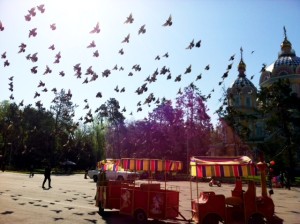
1. Visit Zenkov Cathedral at Panfilov Park
Address: Kazybek Bi Street
While Almaty has no lack of beautiful parks, the Panfilov Park is home to the beautiful mustard-colored, blue-and-white-domed Zenkov Cathedral, one of Almaty’s few surviving tsarist-era buildings. This cathedral was built in 1904 by A. P. Zenkov and renovated in 1955. It is a lasting bastion of old-school European romanticism, from its colorful stained glass windows, the beautiful acoustics of its choir, and location in the park’s main square that is filled with gelato stands, rollerbladers, cotton candy stands, canoodling lovers, and a French-music-playing accordion player. Add to that swooping, swirling black birds that chase after bread crumbs thrown by kids and their babushki, and you will almost think you’re in a nostalgic Soviet film. The park is also infused with history. East of the church there is a Soviet memorial dedicated to the Panfilov Heroes, after whom the park is named. These 28 soldiers of an Almaty infanty unit died fighting the Nazis in a village outside Moscow in 1941. There is also an eternal flame that commemorates those who died in the Civil War (1917-1920) and WWII (1941-1945).
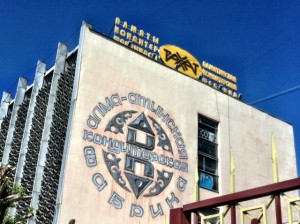
2. Stop by Kazakhstan’s Chocolate Factory Store
Address: Zenkova Street, 2а
Indulge your sweet tooth at Kazakhstan’s most loved confectionary, Rakhat Chocolate Company. It won’t be hard to find. Walk along Zenkova Street and the aromatic waft of chocolate from its factory will hit you like a ton of bricks. It is intense, compelling, almost criminal, and you will be following your nose until you reach the golden gates of Rakhat, which in Kazakh means “pleasure.” Though the factory is not always open for tours, you can enter the retail outlet, where you can choose from over 300 varieties of chocolates and sweets, all wrapped in beautifully designed wrappers of different Kazak, Central Asian, and Russian themes. My favorites are the delectable “Kara Kum” and “Pushkin” chocolates. Buy souvenir-ready boxes of chocolates with Kazakh emblems for your lucky loved ones, or select a few pieces for yourself for a late-afternoon pick-me-up.
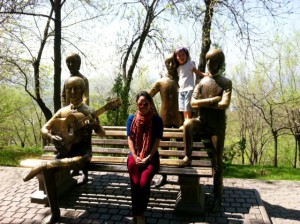
3. Chill on a Bench with the Beatles on Kok-Tobe
Address: Behind Hotel Kazakhstan and the Republican Palace
Cost of cable car one-way: 1,000 Tengre ($6.62)
Take a cable car up the highest point in Almaty, the 1,000-meter “Green Hill,” and take a picture with life-sized bronze statues of the four Beatles. This monument, the only in the world showing the Fab Four together, was designed by local Almaty sculptor Eduard Kazaryan and put in place in 2007. After saying “hello, goodbye,” check out some of the area’s recreational activities. Feed Uzbek Kulangi chickens at the petting zoo, watch young men attempt to ride a mechanical bull, dine at one of the outdoor cafes, and ride a roller coaster that snakes around the mountain. And of course don’t forget to take a picture by a fountain of a big apple — since, after all, Kazakhstan is the birthplace of the apple (Almaty’s old name, “Alma-Ata” means “father of the apples.”)
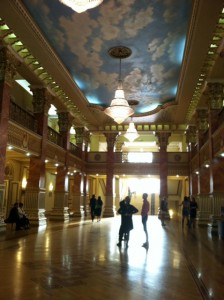
4. Catch a Show at the Abay State Opera and Ballet Theater
Address: Kabanbai Baatira 110, Panfilov Street
Cost of Opera Tickets: 1,200 -2,500 Tengre ($8.00 – $17.00)
Come to this golden, shiny, modern theater, first built in 1934, for a world-class performance. There are at least three or four shows a week, at either 5:00pm or 6:30pm. On April 21st, there was a performance of Guiseppe Verdi’s “Un Ballo in Maschera.” The local opera company gave a phenomenal performance in Italian to a stirring live orchestra. Not only that, the theater provided simultaneous Russian translations of the Italian opera lyrics on two flat screens left and right of the stage. During intermission, you can wander the golden chandelier-laden hallways, admire portraits and photographs of Kazakhstan’s national ballet and opera troupes, watch old clips of past performances on flat-screened televisions, and order a delicious honey cake and mocha from the bar.
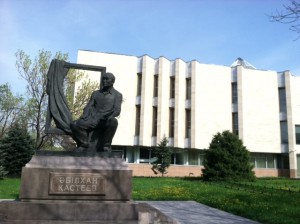
5.Wander the Kazakhstan Museum of Arts
Address: Musirepov 22
Cost of admission: Students 50 Tengre, Students and Pensioners 70 Tengre, Adults 100 Tengre
This sleek museum of arts has a fantastic collection of Soviet and contemporary art from the former Soviet Union and particularly from Kazakhstan. Internalize the Kazakh spirit, history, and soul with representations of nomads, yurts, kumis, traditional dress, and the Ala-Too Mountains. For those interested in a less idealized representation of the region, there is a more cutting-edge section that offers works from green glass elephants made from vodka bottles, to photographs of Central Asian labor migrants. My favorite piece is “Mutation” (1964) by political artist Erbossyn Meldibekov, who molded five busts of Lenin according to different political figures. There is Lenin as himself; Lenin as Mongol warrior Genghis Khan; Lenin as Swiss artist Alberto Giacometti; Lenin as Congolese independence leader Patrice Lumumba; and Lenin as an inverted inversion of himself. It is a refreshing take on a ubiquitous face in post-Soviet Central Asia. Is that you, Dear Leader?
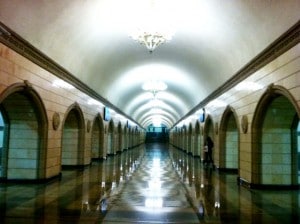
6. Take the Metro, Love the Busses
If you’re coming from Bishkek, you will find respite in the public transportation. There are no marshrutki here, only busses, and they are easy to navigate and are quite spacious. In fact, they are almost eerie. What, no elbowing necessary? One ride costs 80 Tengre (about 50 cents.) Almaty also has a spankin’ new metro system, opened only in 2011. It is the second metro system in Central Asia (the first was in Tashkent, Uzbekistan), and it is still as shiny as a newly minted penny. Take a ride. It took Kazakhstan more than 23 years to build it. (Long story short: Construction started in 1988, and then stalled after 1991 with the collapse of the Soviet Union.)
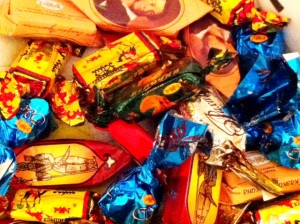
7. Plan a Return Trip
Inevitably, a spring weekend in Almaty will leave you wanting more. Talk to the locals about returning to Kazakhstan to explore other parts of the country, such as its capital, Astana, and the famous Lake Balkhash, the 12th largest lake in the world that is half freshwater, half saltwater (the lake is divided into two parts, separated by the Saryesik Peninsula). Or just make plans to return to Almaty to visit museums you couldn’t visit the first time (for me, it was the Museum of Musical Instruments, and the Presidential Park). Or just come to restock on Rakhat chocolates. Don’t delay. Almaty awaits.

